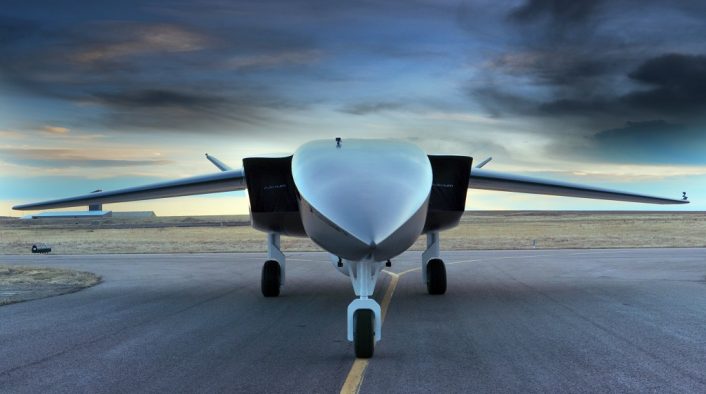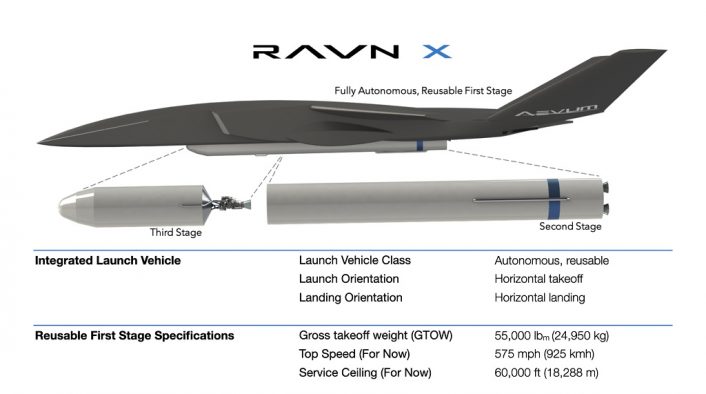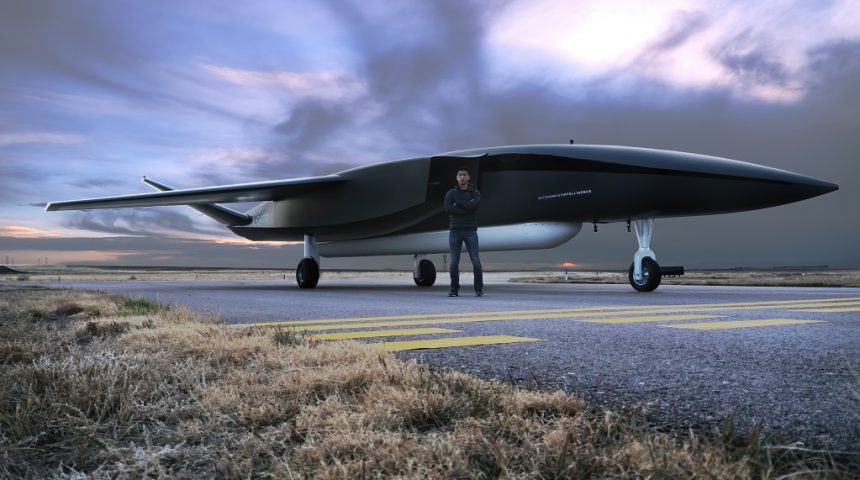The company already secured a contract for the ASLON-45 mission of the U.S. Space Force.
Aevum, a small company based in in Huntsville, Alabama, rolled out its Ravn X Autonomous Launch Vehicle from their hangar at Cecil airport in Jacksonville, Florida, during a live streaming on Dec. 3, 2020.
The aircraft, with tail number N567RX, has been defined by Aevum as “the world’s largest Unmanned Aircraft System (UAS) by mass”, and is designed to deliver small satellites to space efficiently and with minimal resources, both human and economic, aiming to give access to space virtually to anyone: a concept similar to Virgin Orbit’s LauncherOne, but based around an unmanned aircraft instead of a Boeing 747.
Jay Skylus, founder and CEO of Aevum, said that he got the inspiration for this ambitious project when, back in 2005, he came across the news of U.S. soldiers killed in Afghanistan, a news that he felt really personal as his own brother was in the Army, and he discovered that a key factor to those deaths were the difficulties faced by communication systems in the country, which in turn were caused also by the logistics barriers that prevented a quick and easy access to space to deploy new communication technologies.
Aevum says it is already profitable and generating revenue, with its first launch for the U.S. Space Force’s ASLON-45 mission in late 2021.
Ravn X rollout video: pic.twitter.com/LHhM8peh9f
— Michael Sheetz (@thesheetztweetz) December 3, 2020
While he didn’t specify, it’s possible that Skylus was referring to Operation Red Wings, a joint U.S. military mission in Kunar Province in 2005, portrayed in the book and movie “Lone Survivor” by former U.S. Navy SEAL Marcus Luttrell, the only surviving member of the mission. Officials after the operation stated: “Due to Afghanistan’s mountainous terrain and lack of existing communication infrastructure, serious communication challenges prevented the four-man SEAL patrol from effectively establishing contact with their combat operations center, leaving them vulnerable to the attacks that claimed the lives of 19 U.S. special operations service members.” A first solution developed to solve this problem was the E-11A BACN (Battlefield Airborne Communications Node).

After initial self-funded research, Skylus founded Aevum in 2016, starting to work on the prototype and the launch system, which heavily relies on software and automation technologies and allows a 90% reduction in labor, requiring just six people on the ground to perform an operational launch. The concept of operations appears very simple, with the customer only required to login on the website, select the date and location of the launch and the A.I.-driven Autonomous Launch Architecture will perform simulations to determine the optimal trajectory, autonomously launching the Ravn X.
“Aevum is completely reimagining access to space. The current definition of rocket science doesn’t work for us. With Aevum, everyone will be able to say, ‘It is rocket science and I can do it.’ Aevum is pushing logistics to the next generation with software and automation technologies,” said Skylus. “U.S. leadership has identified the critical need for extremely fast access to low Earth orbit. We’re faster than anybody. To me, space is merely a vantage point from which the next generation can commit global progress. Through our autonomous technologies, Aevum will shorten the lead time of launches from years to months, and when our customers demand it, minutes. This is necessary to improve lives on Earth. This is necessary to save lives.”
The UAS is the reusable first stage of the launch vehicle, with the second and third stages being rockets strapped in a semi-recessed position underneath the fuselage. All three stages use Jet A fuel, the same used by commercial airliners, and standard support equipment to reduce the burden on logistics, with the rocket using also Liquid Oxygen (LOX). The Ravn X is 80 ft (24 m) long, 18 ft (5.5 m) tall and with a wingspan of 60 ft (18.3 m), while the gross takeoff weight of 55’000 lb (24’950 kg). The configuration is quite conventional, with a high wing and canted tail planes, powered by two unspecified afterburning engines spaced up to create enough space for the payload under the fuselage. The provisional maximum speed and altitude are 575 mph (925 km/h) and 60,000 ft (18,288 m).
From the start only the first stage will be reusable, making up for a 70% reusability of the complete system, but the company is working to obtain up to 95% reusability. No specialized launch infrastructure is needed, with Ravn X requiring only a mile-long runway. Because of this, Aevum hopes to create spaceports all over the word near its customers, with the first one being Cecil Field in Jacksonville. The UAS is programmed to avoid the weather as well, allowing a 96% availability since there is no need to scrap a launch because of adverse weather conditions like for classic rockets.
Another factor allowing that high availability is the possibility to prepare the Ravn X for another flight in just 3 hours and to launch multiple UASs at the same time, performing simultaneous zoom climbs to launch the rockets that will transport the payloads to low-Earth orbit and then returning back and landing like a standard airplane. In a interview released to SpaceNews, Skylus said that, since the Ravn X is not a carrier aircraft, but rather a real first stage, it will accelerate the rocket on its initial trajectory and, when it reaches the launch point, the second stage’s two rocket engines will be ignited immediately after the drop, just after half a second to one second on separation, minimizing the energy bleed. This can only be done because the system is unmanned and therefore there is no risk for human life if the launch goes wrong.
Even before the prototype’s rollout, Aevum has been awarded government contracts totaling over $1 billion including the upcoming ASLON-45 (Agile Small Launch Operational Normalizer) mission with the United States Space Force, the first formal small launch mission contracted by the new service, an AFWERX Small Business Innovation Research (SBIR) Phase II contract for rapid launch and space logistics, and the Orbital Services Program-4 (OSP-4), Indefinite Delivery/Indefinite Quantity contract of the USAF Space and Missile Systems Center’s Launch Enterprise Small Launch and Targets Division, giving Aevum the ability to compete for 20 missions over a 9-year period.

Because of this, Lt. Col. Ryan Rose, Chief of the Space and Missile Systems Center’s Small Launch and Targets Division at Kirtland Air Force Base in Albuquerque (New Mexico), took part in the rollout streaming. “I’m excited to see the bold innovation and responsiveness in development today by our small launch industry partners to support emerging warfighter needs,” said Lt. Col. Rose. “The U.S. Space Force is proactively partnering with industry to support U.S. space superiority objectives. Having a robust U.S. industry providing responsive launch capability is key to ensuring the U.S. Space Force can respond to future threats.”
According to the company’s website, the Ravn X performed a first autonomous taxi test last month, with further test already planned to continue the certification process, with the system scheduled to be ready for operations within the next 18 months.









